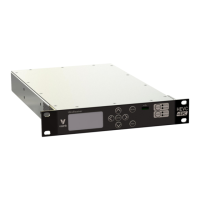UltraReceiver User Manual
Receiver Setup
Issue No: 3 Page: 31
Ref: ULRX-ASUM-700X Copyright © 2018 Vislink plc
Table 6-3 defines the changes and sequence required when changing to LMS-T operation.
LMS-T (S) or (D) or DVB-T
3..12MHz (S) or
4..24 MHz (D)
Table 6-3 LMS-T-T Operation Menu Overview
The table below defines the corresponding gross bit rates for LMS-T operation at the most
common bandwidths (Single or Dual pedestal):
Bitrates (Mbit/s) for a LMS-T system
Table 6-4 LMS-T Bitrate Operation
Selecting the downconverter type will automatically define the frequency ranges and
spectral inversion.
Switch the decode to decode a transport stream from either the demodulator output or an
external source from the rear panel ASI-In socket.

